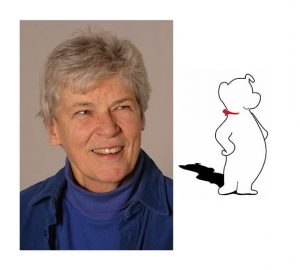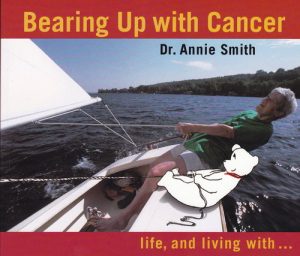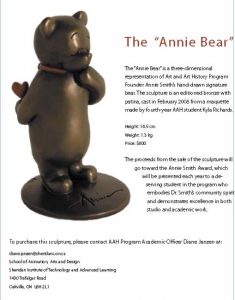
BY CHRISTY JANSSENS
Who was Annie Smith?
There is a building at the Sheridan Trafalgar Campus bearing her name. If you go inside, you’ll see her picture hanging on the wall. She’s in a sailboat on the open water wearing khaki shorts and a forest green t-shirt. She’s leaning back, bracing herself in the boat with her head thrown back. She’s smiling. She looks full of life.
This picture is also the cover of her book, an account of her journey called Bearing up with Cancer. On the cover, a small white cartoon bear is pictured in the boat beside her. When you understand who Annie Smith was, this picture becomes not only poignant, but a perfect cover image.

Annie Smith was originally from Elmira N.Y, but came to Toronto in 1969, according to a Globe and Mail article written by John Armstrong, current program coordinator of Art and Art History at Sheridan. She became program coordinator of the Art and Art History program, offered jointly with the University of Toronto and Sheridan College, in 1976. A beloved professor and respected educator, she died in 2007 at 67 years old after battling cancer for 20 years, according to her biography on the University of Toronto Mississauga website.
“She was a person of great probity,” said Armstrong. “She was highly ethical. She did not abide with deceit of any kind. She was quite firm on that point. Students. Faculty. Administration. She defended the budget space and studio time vociferously. She was wonderful, positive, and all that but she could be a tough cookie when she wanted to be. She spoke her mind in no uncertain terms.”
“She would send us notes with those bears on them,” he said. “If she was unhappy, bear would be unhappy. Bear was her alter ego. On all of her notes, if she sent you a note, she would just write it out on a piece of paper and then draw the bear on it doing something crazy.”
“She saw herself as a bear,” he said. “A short, kind of rotund bear.”
This bear became more than a simple characterization. It lives on as a bronze sculpture, created in 2008 by art and art history student Kyla Richards.
“The idea was that it would be for fundraising for the school,” said Richards. “So people could purchase this Annie bear and the fundraising would go into the Annie Smith scholarships.

Richards met Smith and learned more about the Annie bear.
“I knew of Annie Smith and I had seen her about the building once before,” said Richards. “I met her and basically had the pleasure of hanging out with her for an entire awards ceremony. We talked about all different sorts of things. She wrote a book basically just showing her battle with cancer and she was a bear in it. She said that showing herself as a bear in the book allowed her a lot of freedom to show things that she couldn’t have shown if she was actually showing a real representation of herself.
“It allowed her to distance herself from the actual story in order to be able to write it. So she wasn’t showing pictures of herself naked in the shower discovering a lump; it was this white fluffy bear. She had always loved bears and this little bear that she’d illustrated in this book became the Annie bear. And it became a really big part of her.
Richards said that around this time, there was talk about creating a portrait of Annie for the school. “I talked to Annie a bit about that,” said Richards, “and she said ‘Well, I don’t want myself sculpted but I would love the Annie bear sculpted.’
“Shortly after that- I think about a month or two within that time frame, her cancer came back. She went back in for chemotherapy. We were in email contact about the Annie bear and she said that she wanted to keep the bits of her hair that fell out and make an actual Annie hair wig- like a little bear hat for the bear.”
Unfortunately, that never happened.
“I sent another email after that and it wasn’t Annie who replied,” said Richards. “It was someone else who was checking her emails and she basically said that Annie was so sick that she couldn’t do it. She actually died shortly after that. So she didn’t actually get to see the Annie bear. I wish she would have been able to see it. It would have been so cool.”
It’s a weighty project to take on, as a student.
“It was pretty intense. I wanted to make [the sculpture] flawless,” said Richards. “That was interesting because I had never tried to make anything without a flaw. I normally incorporate flaws into my pieces, but this one, because it was so smooth, and very specific shapes that I was trying to make follow the shapes she’d used in her drawings- I didn’t feel a lot of pressure from anyone else but I felt a lot of pressure from myself.”
Richards said that she wanted the sculpture to do justice to Smith’s memory.
“She was an absolute inspiration,” said Richards. “Nothing got her down. When I received that last email from someone else answering her email and they said she was too sick, I had this horrible sense of foreboding. Like, if Annie Smith is too sick to check her emails, this is bad.”
Richard’s reflection on Smith’s influence echoes what most people say when they remember her.
“I spent a very short time with her and she had a massive impact on me.”
Annie gave an alumni address in October 2001. Some of her spirit still has life in these words.
I have lost quite a bit in these last two years. And I don’t mean just the body parts due to operations or the memory and hair loss due to chemotherapy. I have lost the direct contact with you and this Program. I have lost the energy that goes into working with each of you. I have lost that special creativity that goes into course preparations as you strive to put together what will inspire the students in constructive and imaginative work.
But I have gained a lot, too. I gained some weight! But I also gained perspective, and you all know that for artists, that’s a very special thing to have. I have gained a perspective on life and I have gained a perspective on this Program. Regarding the perspective on life, it is really quite simple: keep your sense of humour; keep moving; and keep positive in your contributions to yourself and to others. And as for the Program, I have gained the perspective to know how strong this Program is, how dedicated the students and faculty and staff continue to be. We started out as a sharing and supportive group with our primary goal to give the most we could to each other and I can see how fervently this goal remains. I am so very proud to have been a part of this Program.
